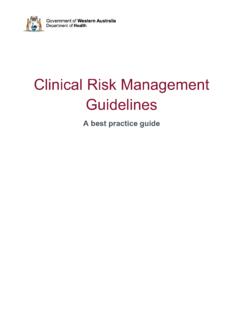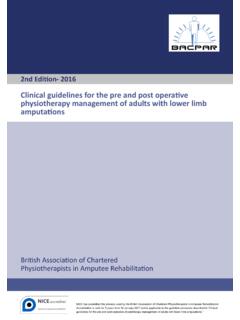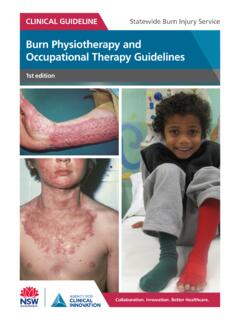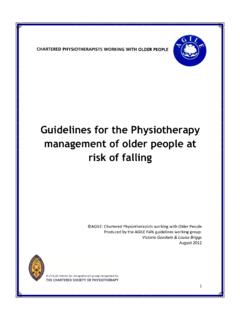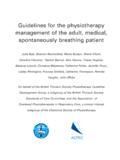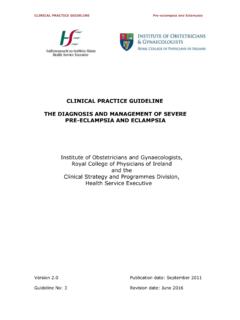Transcription of Management of Noonan Syndrome - The RASopathies …
1 Noonan Syndrome clinical Management guidelines Management of Noonan Syndrome A clinical Guideline Noonan Syndrome Guideline Development Group Noonan Syndrome clinical Management guidelines 2 Contents Introduction 3 .. to Noonan Syndrome 3 .. to the Noonan Syndrome guidelines Development project 3 .. to the Noonan Syndrome clinical Management guidelines 3 Diagnosis and clinical features of Noonan Syndrome 4 Recommended baseline investigations in Noonan Syndrome 5 Recommendations for the Management of Noonan Syndrome 6 .. in neonates & infancy 6 .. in childhood 8 .. in adolescence 11 .. in adulthood 13 Noonan Syndrome Growth Charts 15.
2 Boys Length for Age and Weight for Length: 0 36 months 15 .. Girls Length for Age and Weight for Length: 0 36 months 16 .. Boys Stature and Growth Velocity for Age: 2 20 years old 17 .. Girls Stature and Growth Velocity for Age: 2 20 years old 18 References 19 Information for Parents 29 Acknowledgements 30 Noonan Syndrome clinical Management guidelines 3 - Childhood: 1 11 years old - Adolescence: 11 18 years old - Adulthood: 18 years old + - Neonatal and Infancy 0 1 years old .. to Noonan Syndrome (NS) Noonan Syndrome (NS) is one of the more common genetic conditions.
3 The incidence of NS is estimated as 1 in 1,000 to 1 in 2,500 births, so it is still a relatively rare condition. The severity of NS is the same in males and females. The main features are congenital heart defects, short stature and characteristic facial features. Early motor delay associated with hypotonia is not necessarily associated with later learning difficulty, and most adults with NS are able to lead independent autonomous lives.. to the Noonan Syndrome Guideline Development Project The guidelines have been developed using a robust methodology based on the one utilised by the Scottish Intercollegiate guidelines Network (SIGN). The method has been adapted to suit rare conditions where the evidence base is limited, and where expert consensus plays a greater role.
4 The members of the guideline development group are listed on page 30.. to the Noonan Syndrome clinical Management guidelines What are the aims of the guidelines ? The guidelines aim to provide clear and wherever possible, evidence-based recommendations for the Management of patients with Noonan Syndrome . Who are they aimed at? These guidelines are provided for people with NS to use with their primary care and specialist clinicians as many healthcare professionals will not have had personal experience of managing Noonan Syndrome . As it is a multisystem disorder, people with NS may require various tests, screening, assessments, referrals and multidisciplinary interventions at different stages of their lives.
5 These guidelines lay out these requirements in a clear format that is accessible to anybody who is involved in the care of an individual with NS. How are they organised? The guidelines are divided into recommendations for four age groups: Page 4 contains an overview of the diagnostic criteria and clinical features of NS, and page 5 lists the suggested baseline investigations. Subsequently, the guidelines are organised into specific age groups. For each group, Management issues along with any recommended tests/screenings are listed, and follow-up options depending on the outcome of the test or screening are indicated. NB. ABNL= Abnormal A full list of references starts on page 19, organised by body system, which can be used as a signpost to further information on specific aspects of NS for healthcare professionals.
6 Additionally, there is a list of useful contacts for parents and families affected by NS, on page 29. Noonan Syndrome clinical Management guidelines 4 Diagnosis and clinical features of Noonan Syndrome Diagnostic features of NS (van der Burgt 1997) Definitive NS: Differential diagnoses: Cardio-facio-cutaneous Syndrome (CFC) Costello Syndrome LEOPARD Syndrome King-Denborough Syndrome (phenotypically distinct. Malignant hyperthermia is not described in NS) NB Neurofibromatosis- Noonan Syndrome formed part of the differential diagnosis in the past; it is now known that some patients with either of these conditions will have overlapping clinical features, due to the causative mutations occurring in the same biological pathway.
7 Feature A = Major B = Minor 1. Facial Typical face (Facial features of NS vary over time and may have only subtle differences. Expert assessment is therefore Required. See Allanson 1987 full reference ). Suggestive face 2. Cardiac Pulmonary valve stenosis and/or hypertrophic cardiomyopathy (HCM) Other cardiac defect 3. Height < 3th centile < 10th centile 4. Chest wall Pectus carinatum/excavatum Broad thorax 5. Family History First degree relative with definite NS First degree relative suggestive of NS 6. Other Mild developmental delay, cryptorchidism AND lymphatic dysplasia Mild developmental delay, cryptorchidism, OR lymphatic dysplasia *Currently, mutation testing will prove a diagnosis of Noonan Syndrome in 70% of cases; in 30% the responsible gene remains unknown.
8 The diagnosis of NS should be considered in parents when a child is diagnosed with the Syndrome . Given the number of different genes where mutations can cause NS, the appropriateness and sequence of gene testing should be decided by a clinical geneticist. Criterion 1A + One of 2A 6A Two of 2B 6B Two of 2A 6A Three of 2B 6B Criterion 1B + Noonan Syndrome clinical Management guidelines 5 Baseline investigations Full cardiac evaluation at diagnosis. Monitor and plot growth on appropriate NS and age-based growth chart. Refer patient in second half of first year or at diagnosis for formal developmental assessment. Baseline neuropsychological assessment at primary school entry.
9 Refer for renal ultrasound at diagnosis. Carry out baseline coagulation screening in patients aged 5+, or earlier if major procedure to be undertaken. (Prothrombin Time (PT) Activated Partial Thromboplastin Time (aPPT) and FXI assay.) Refer for specialist ophthalmology assessment at the point of diagnosis. clinical Features of Noonan Syndrome Congenital heart defects ( pulmonary stenosis, hypertrophic cardiomyopathy, atrial septal defect) Failure to thrive/slow growth rate/feeding problems Short stature Developmental delay and neuropsychological/behavioural issues Minor renal anomalies Bleeding disorders Visual problems ( segment ocular changes and anterior segment ocular abnormalities) (where an investigation is not indicated for a specific clinical feature, please refer to the relevant age group-specific page for Management recommendations)
10 Recommended baseline investigations in Noonan Syndrome Noonan Syndrome clinical Management guidelines 6 0 1 AGE ABNL ABNL ABNL ABNL ABNL ABNL Recommendations for the Management of Noonan Syndrome ~ in neonates & infancy (1) ~ Recommended Testing/Screening clinical Management Recommendations Feeding assessment Refer for dietary assessment and evaluation of swallowing if needed. Refer to speech therapist for Management if necessary. Frequent vomiting should prompt investigation for gastro-oesophageal reflux and malrotation. Treat with anti-reflux measures. Persistent vomiting or food refusal may require tube feeding (although this is rare). Full cardiac evaluation At diagnosis.
